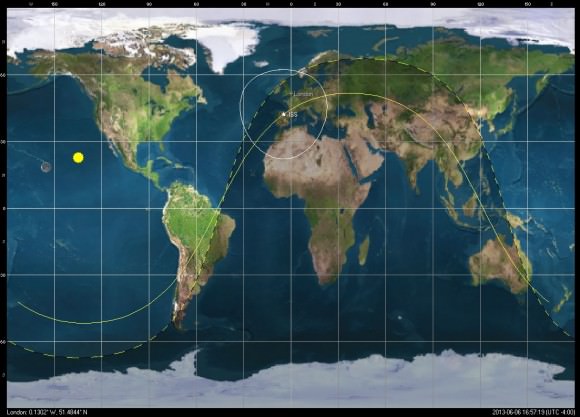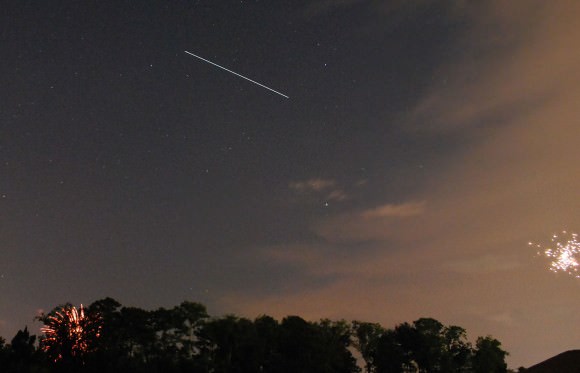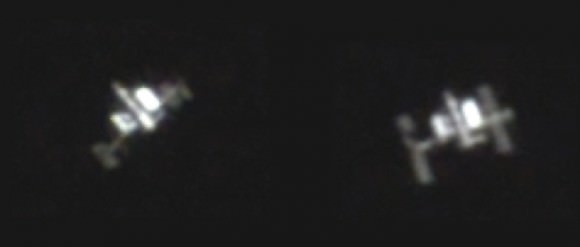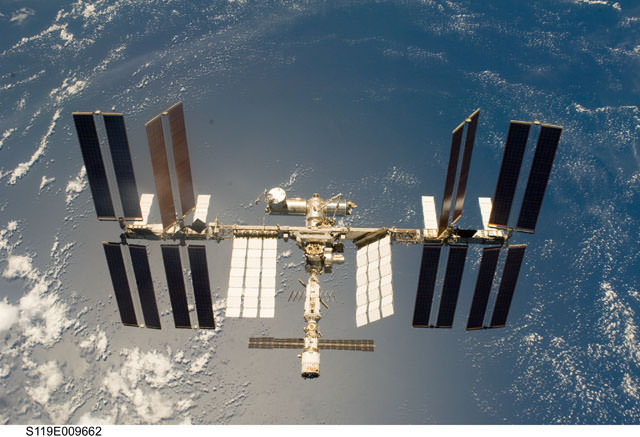Never seen the International Space Station before? Now is a good time to try, as we enter into a very special time of year.
Starting at 12:30 Universal Time/8:30 AM EDT on Monday, June 3rd, the ISS will enter a phase of permanent illumination throughout the length of its orbit. The station will remain in sunlight and will not experience an orbital sunset until five days later, when it briefly dips into the Earth’s shadow on June 8th at 11:50 UT/ 7:50 AM EDT.
This sets us up for a wealth of visible passes worldwide. This unique phenomenon occurs as a product of the station’s highly inclined orbit. Tilted at 51.6° with respect to the Earth’s equator, its orbit can be oriented roughly perpendicular to the Sun within a few weeks of either solstice.
But whereas the December solstice favors multiple summer sightings for the southern hemisphere, the season near the June solstice (which occurs this year on June 21st) favors northern latitudes. In fact, observers in the UK, southern Canada and the northern United States will be able to see multiple ISS passes in one night over the next week. Note that the ISS is nearly in full illumination now, and will remain so well into mid-June.
So, why was the ISS put into such a highly inclined orbit?
This orientation enables international partners to have access to the station from launch complexes worldwide. Whereas the shuttle launched on construction flights from Cape Canaveral at 28.5° north latitude, the Progress and crewed Soyuz missions depart from the Baikonur Cosmodrome in Kazakhstan located at 46° north. This resulted in some dramatic launches from the US Florida Space Coast, as the shuttle chased the ISS up the US Eastern Seaboard and was often visible minutes later crossing over the UK.
Though born of practicality, this happy circumstance also means that the ISS is visible to a wide swath of humanity located from 60° north latitude to 60° south. Only locales such as Antarctica, Greenland, and Iceland miss out.
I’m often asked how I know a moving star is a satellite and not an airplane. Aircraft flash, generating their own light, while satellites shine by reflected sunlight. This means that there’s a window of about an hour after sunset or before local sunrise that objects in low Earth orbit are still illuminated high overhead. In the early morning hours, if often seems as if someone has just “flipped on a switch” and satellites suddenly become visible across the sky.
And yes, satellites can flash as well, but in most instances, this is due to tumbling or the observer catching a glint of sunlight off of a reflective panel or surface just right. The Iridium constellation of satellites is known for this effect, but the ISS and Hubble Space Telescope can also flare in this fashion as well.
At 108.5 x 72.8 metres in size, the ISS is the largest man made object ever constructed in Earth orbit. Its unmistakable to spot as it passes overhead, shining at a maximum illumination brighter than the planet Venus at magnitude -5.2 when 100% illuminated.
Note the time the ISS is passing over your location and the direction its coming from and just start watching, no equipment required. It’s really as simple as that. Many prediction platforms exist for ISS passes. I’ve used Heavens-Above for over a decade now to spot ISS passes worldwide. Probably the simplest tracker out there is provided by Spaceweather. Just enter in your postal code and it kicks out an easy to decipher prediction. NASA also has a “Sighting Opportunities” webpage where you can choose your country and city to find out when the ISS will be passing over your location.
More advanced satellite trackers many want to check out CALSky which can also provide a list of transits of the ISS in front of the Sun or Moon from your location. I’ve managed to catch one each from my backyard utilizing it. I also like to use a free satellite tracking program known as Orbitron, which can be run on a laptop in the field away from an Internet connection.

Photographing a pass of the ISS is easy. Just do a wide field exposure with a DSLR camera on a tripod for 10-30 seconds and you’ll get a picture of the ISS streaking across the starry background. Be sure to use manual mode and either set the focus to infinity or focus on something bright such as Venus just prior to the pass. I generally take a series of test exposures prior to get the combination of ISO/f-stop settings correct for the current sky conditions.

I can just make out structure on the ISS with binoculars as it passes overhead. This appearance can vary greatly depending on its orientation. Sometimes, it looks like a close binary star. Other times it can appear box-shaped. Occasionally, it looks like a tiny luminous Star Wars TIE-fighter!

The station managers typically orient the huge solar arrays to provide a small amount of artificial shadow during phases of full illumination. The ISS extends ~45” across at closest approach, similar in apparent diameter to Saturn including its ring system.
You can even image the ISS through a telescope, with a little skill and luck. Many sophisticated mounts will track the ISS as it crosses the sky, or you can use our own low-tech method;
Be sure to check out an ISS pass coming to a sky near you!


Somewhere I heard of the tripe conjunction- http://musetheplace.com/venus-jupiter-and-mercury-seen-in-a-rare-triple-conjunction/
I like watching the ISS fly over every chance I get! It’s a thrill seeing it and knowing there are 3-6 people on board. At one viewing, when the shuttle was up, there were 13 people on board. This during a public star gazing event at the Roger Fergusson Obs. in Sonoma County… The crowd went nuts when it was pointed out. My 7X35 binocs sometimes shows the solar panels – elevation and pass dependent. I have several images taken with a basic digital camera – a long streak, like in your image above – Unfortunately, my telescope will not track the ISS. Imaging by manually tracking with any kind of magnification has proven unsuccessful… so far… but I’m working on it! ~@; )
And of course I leave for Alaska tomorrow and will be at a latitude of about 65 degrees North for the next couple of weeks!